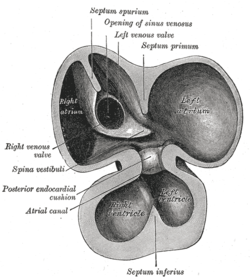Primary interatrial foramen
In the developing heart, the atria are initially open to each other, with the opening known as the primary interatrial foramen or ostium primum (or interatrial foramen primum). The foramen lies beneath the edge of septum primum and the endocardial cushions. It progressively decreases in size as the septum grows downwards, and disappears with the formation of the atrial septum.
| Primary interatrial foramen | |
|---|---|
 The developing human heart, at day 30. The ostium primum joins the primitive atrium and lies beneath the septum primum (top middle) and becomes progressively smaller as the septum grows in size. | |
| Details | |
| System | Cardiovascular system |
| Location | Developing heart |
| Identifiers | |
| Latin | foramen primum |
| TE | E5.11.1.5.2.1.1 |
| Anatomical terminology | |
Structure
The foramen lies beneath the edge of septum primum and the endocardial cushions. It progressively decreases in size as the septum grows downwards, and disappears with the formation of the atrial septum.
Closure
The septum primum, a septum which grows down to separate the primitive atrium into the left atrium and right atrium, grows in size over the course of heart development. The primary interatrial foramen is the gap between the septum primum and the septum intermedium, which gets progressively smaller until it closes.
Clinical significance
Failure of the septum primum to fuse with the endocardial cushion can lead to an ostium primum atrial septal defect.[1] This is the second most common type of atrial septal defect[2] and is commonly seen in Down syndrome. Typically this defect will cause a shunt to occur from the left atrium to the right atrium. Children born with this defect may be asymptomatic, however, over time pulmonary hypertension and the resulting hypertrophy of the right side of the heart will lead to a reversal of this shunt. This reversal is called Eisenmenger syndrome.
References
This article incorporates text in the public domain from page 512 of the 20th edition of Gray's Anatomy (1918)
External links
- Embryology at Temple Heart98/heart97a/sld036
- Overview and diagram at um.edu.mt
- MedEd at Loyola GrossAnatomy/thorax0/Heart_Development/Atria.html